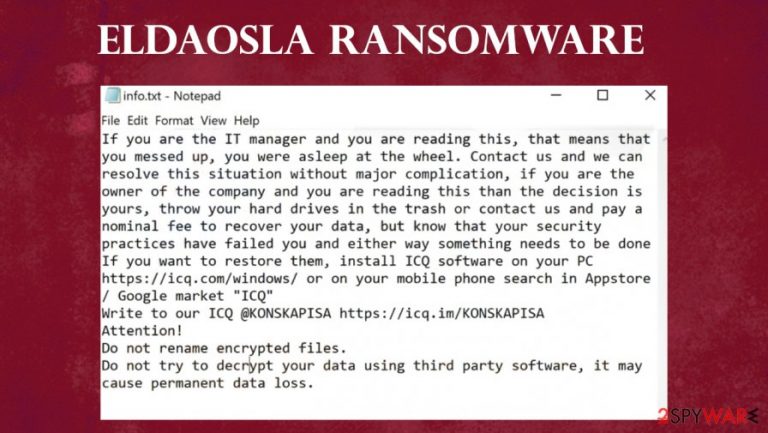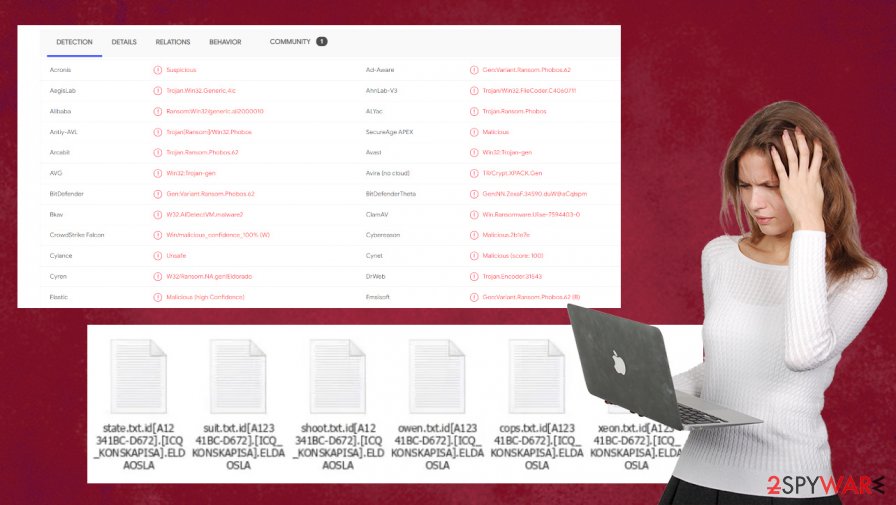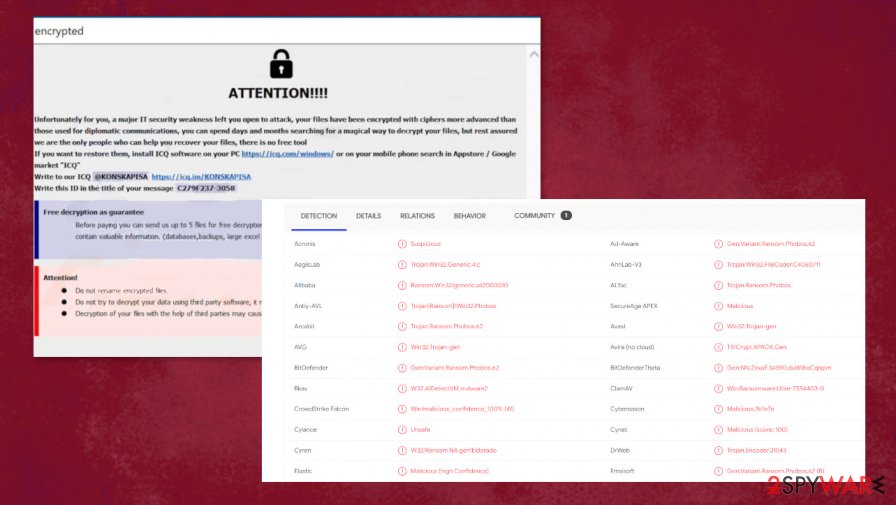ELDAOSLA ransomware (Virus Removal Guide) - Recovery Instructions Included
ELDAOSLA virus Removal Guide
What is ELDAOSLA ransomware?
ELDAOSLA ransomware – a new file-locking virus from Phobos ransomware family

Developers of ELDAOSLA virus, in both ransom demanding notes, are warning the victims not to rename the files or try and decrypt them with any third-party software, as it may lead to permanent data loss. They graciously offer free decryption of up to 5 files to prove that they can and will decode user files after payment of some sort is made (most probably in cryptocurrency Bitcoins). Cybercriminals provide their ICQ messenger ID (@KONSKAPISA) to contact them and explain how to get that app on either a PC or a mobile phone. The message in the info.txt is quite humorous; you can read both ransom notes at the bottom of this paragraph.
| name | ELDAOSLA ransomware |
|---|---|
| Type | Cryptovirus, Ransomware |
| family | Phobos ransomware family |
| appended file extension | Three-part extension appended to all non-system files |
| ransom note | Two similar ransom notes are generated. One appears as a .txt file, the other as a pop-up window |
| criminal contact details | Criminals give their ICQ Messenger contact – @KONSKAPISA |
| distribution | Torrent websites, file-sharing platforms, infectious email attachments |
| ransomware removal | Trustworthy anti-virus software should be used to remove ELDAOSLA ransomware |
| system tune-up | Unfailing system tune-up FortectIntego tool should be used to undo any harm the ransomware did to the devices' system files |
Despite the fact that agreeing to pay the ransom to the cybercriminals might seem like the only viable option to get encrypted data back, there are numerous examples[1] that after complying with the demands, victims either got scammed more or didn't hear back from the perpetrators at all. If users had backups – great!; remove ELDAOSLA ransomware with a dependable anti-malware software like Malwarebytes or SpyHunter 5Combo Cleaner and afterward restore the data from backups.
If the victims didn't have a powerful anti-virus app that would have prevented the ELDAOSLA files virus from infecting their devices and didn't keep backups – a tough choice is upon thee. Not many choices are available, either pay the requested ransom and pray that the cybercriminals will be honest enough to deliver on their promise; export all contaminated data to offline storage like a USB drive and wait for a public key to be created to unlock encrypted files, or format hard drives and rebuild the system from scratch.
Whichever option victims choose, experts[2] advise using the FortectIntego tool to automatically scan and fix any issues that the ELDAOSLA virus might have caused to the infected devices' system files and settings. By repairing the damage, computer systems won't exhibit any strange behavior, like crashing, severe lag, etc.

Both ELDAOSLA virus ransom note in the text file encloses the message:
If you are the IT manager and you are reading this, that means that you messed up, you were asleep at the wheel. Contact us and we can resolve this situation without major complication, if you are the owner of the company and you are reading this than the decision is yours, throw your hard drives in the trash or contact us and pay a nominal fee to recover your data, but know that your security practices have failed you and either way something needs to be done
If you want to restore them, install ICQ software on your PC hxxps://icq.com/windows/ or on your mobile phone search in Appstore / Google market “ICQ”
Write to our ICQ @KONSKAPISA hxxps://icq.im/KONSKAPISA
Attention!
Do not rename encrypted files.
Do not try to decrypt your data using third party software, it may cause permanent data loss.
Basic principles used by cybercriminals to affect computer systems
Cybercriminals' job isn't just to create the malware. Their main task is to outsmart computer users: to trick them into opening a mischievous hyperlink to a malicious site where soon to be victims would instantly receive a malware payload file, or open a legitimately looking email with an infectious attachment, or download some licensed software activation tool with contamination hidden within it.
The internet is full of different kinds of viruses just waiting for unaware users to click on them. In this day and age, anti-malware software is a must for all computer users that want to evade dealings with cybercriminals, losing their data, losing their money, harming their precious devices. Always stay mindful while browsing.

Guidelines on ELDAOSLA ransomware virus removal and a quick system fix
Any malware, whether it is ransomware, adware[3], or any other computer software with ill intentions, should be removed from the infected system hastily. To remove ELDAOSLA ransomware victims should use Malwarebytes or SpyHunter 5Combo Cleaner for this anti-malware software will locate all files related to this virus on the infected device and automatically isolate and eliminate them. Furthermore, it will protect computers from probable attacks in the future.
Following successful ELDAOSLA ransomware removal, users should seriously consider doing a full system scan with the FortectIntego tool to detect any changes made to the system settings and its files and repair any damage that has been done. This action will prevent computers from significant operating issues.
Getting rid of ELDAOSLA virus. Follow these steps
Manual removal using Safe Mode
Go for a Safe Mode with Networking reboot, so you can remove ELDAOSLA ransomware
Important! →
Manual removal guide might be too complicated for regular computer users. It requires advanced IT knowledge to be performed correctly (if vital system files are removed or damaged, it might result in full Windows compromise), and it also might take hours to complete. Therefore, we highly advise using the automatic method provided above instead.
Step 1. Access Safe Mode with Networking
Manual malware removal should be best performed in the Safe Mode environment.
Windows 7 / Vista / XP
- Click Start > Shutdown > Restart > OK.
- When your computer becomes active, start pressing F8 button (if that does not work, try F2, F12, Del, etc. – it all depends on your motherboard model) multiple times until you see the Advanced Boot Options window.
- Select Safe Mode with Networking from the list.

Windows 10 / Windows 8
- Right-click on Start button and select Settings.

- Scroll down to pick Update & Security.

- On the left side of the window, pick Recovery.
- Now scroll down to find Advanced Startup section.
- Click Restart now.

- Select Troubleshoot.

- Go to Advanced options.

- Select Startup Settings.

- Press Restart.
- Now press 5 or click 5) Enable Safe Mode with Networking.

Step 2. Shut down suspicious processes
Windows Task Manager is a useful tool that shows all the processes running in the background. If malware is running a process, you need to shut it down:
- Press Ctrl + Shift + Esc on your keyboard to open Windows Task Manager.
- Click on More details.

- Scroll down to Background processes section, and look for anything suspicious.
- Right-click and select Open file location.

- Go back to the process, right-click and pick End Task.

- Delete the contents of the malicious folder.
Step 3. Check program Startup
- Press Ctrl + Shift + Esc on your keyboard to open Windows Task Manager.
- Go to Startup tab.
- Right-click on the suspicious program and pick Disable.

Step 4. Delete virus files
Malware-related files can be found in various places within your computer. Here are instructions that could help you find them:
- Type in Disk Cleanup in Windows search and press Enter.

- Select the drive you want to clean (C: is your main drive by default and is likely to be the one that has malicious files in).
- Scroll through the Files to delete list and select the following:
Temporary Internet Files
Downloads
Recycle Bin
Temporary files - Pick Clean up system files.

- You can also look for other malicious files hidden in the following folders (type these entries in Windows Search and press Enter):
%AppData%
%LocalAppData%
%ProgramData%
%WinDir%
After you are finished, reboot the PC in normal mode.
Remove ELDAOSLA using System Restore
You can try the System Restore feature and get rid of the intruder this way
-
Step 1: Reboot your computer to Safe Mode with Command Prompt
Windows 7 / Vista / XP- Click Start → Shutdown → Restart → OK.
- When your computer becomes active, start pressing F8 multiple times until you see the Advanced Boot Options window.
-
Select Command Prompt from the list

Windows 10 / Windows 8- Press the Power button at the Windows login screen. Now press and hold Shift, which is on your keyboard, and click Restart..
- Now select Troubleshoot → Advanced options → Startup Settings and finally press Restart.
-
Once your computer becomes active, select Enable Safe Mode with Command Prompt in Startup Settings window.

-
Step 2: Restore your system files and settings
-
Once the Command Prompt window shows up, enter cd restore and click Enter.

-
Now type rstrui.exe and press Enter again..

-
When a new window shows up, click Next and select your restore point that is prior the infiltration of ELDAOSLA. After doing that, click Next.


-
Now click Yes to start system restore.

-
Once the Command Prompt window shows up, enter cd restore and click Enter.
Bonus: Recover your data
Guide which is presented above is supposed to help you remove ELDAOSLA from your computer. To recover your encrypted files, we recommend using a detailed guide prepared by 2-spyware.com security experts.If your files are encrypted by ELDAOSLA, you can use several methods to restore them:
Data Recovery Pro is the tool that restores files when data backups are not availiable
You should rely on Data Recovery Pro when files get accidentally deleted or encoded by the virus
- Download Data Recovery Pro;
- Follow the steps of Data Recovery Setup and install the program on your computer;
- Launch it and scan your computer for files encrypted by ELDAOSLA ransomware;
- Restore them.
Windows Previous Versions recovers files after ELDAOSLA ransomware attack
You can restore data affected by the virus if System Restore was enabled before
- Find an encrypted file you need to restore and right-click on it;
- Select “Properties” and go to “Previous versions” tab;
- Here, check each of available copies of the file in “Folder versions”. You should select the version you want to recover and click “Restore”.
ShadowExplorer can help with affected pieces
You can rely on Shadow Volume Copies if you know that those are not affected
- Download Shadow Explorer (http://shadowexplorer.com/);
- Follow a Shadow Explorer Setup Wizard and install this application on your computer;
- Launch the program and go through the drop down menu on the top left corner to select the disk of your encrypted data. Check what folders are there;
- Right-click on the folder you want to restore and select “Export”. You can also select where you want it to be stored.
Decryption tool for ELDAOSLA ransomware is not developed yet
Finally, you should always think about the protection of crypto-ransomwares. In order to protect your computer from ELDAOSLA and other ransomwares, use a reputable anti-spyware, such as FortectIntego, SpyHunter 5Combo Cleaner or Malwarebytes
How to prevent from getting ransomware
Access your website securely from any location
When you work on the domain, site, blog, or different project that requires constant management, content creation, or coding, you may need to connect to the server and content management service more often. The best solution for creating a tighter network could be a dedicated/fixed IP address.
If you make your IP address static and set to your device, you can connect to the CMS from any location and do not create any additional issues for the server or network manager that needs to monitor connections and activities. VPN software providers like Private Internet Access can help you with such settings and offer the option to control the online reputation and manage projects easily from any part of the world.
Recover files after data-affecting malware attacks
While much of the data can be accidentally deleted due to various reasons, malware is one of the main culprits that can cause loss of pictures, documents, videos, and other important files. More serious malware infections lead to significant data loss when your documents, system files, and images get encrypted. In particular, ransomware is is a type of malware that focuses on such functions, so your files become useless without an ability to access them.
Even though there is little to no possibility to recover after file-locking threats, some applications have features for data recovery in the system. In some cases, Data Recovery Pro can also help to recover at least some portion of your data after data-locking virus infection or general cyber infection.







